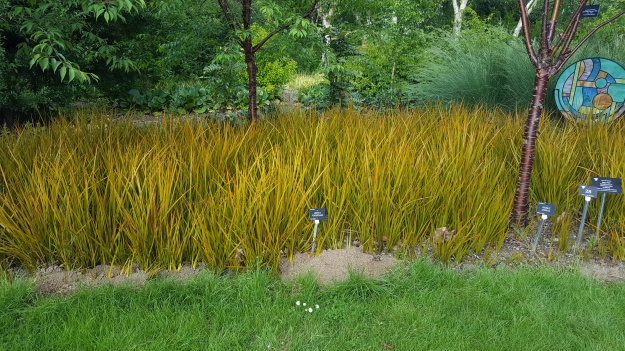One of the signature plants in Cleve West’s design for Horatio’s Garden in Salisbury is Libertia grandiflora. For those of you unfamiliar with it, it’s (to quote the RHS) “a strong-growing, clump-forming evergreen plant, up to 90cm tall, with narrow, dark-green, grass-like leaves. In early summer, white, bowl-shaped flowers, 2-3cm across, are carried on erect stems and are followed by round seed pods in autumn which turn black when they mature.”

Close up, the flowers of Libertia grandiflora are simply stunning.
I’m not sure’bowl-shaped’ really does justice to the flowers, which are gorgeous – and the plant’s real attraction. They float above the strappy foliage on long, arching stems, forming a cloud of pure, white for a few brief weeks in late May and early June.
Sadly, either side of that short flowering season, they retreat to a supporting role, providing a green foil to other, showier plants. Their seed heads remain on their stalks through summer and autumn (unless you cut them off, which we don’t). The leaves, like many grasses, tend to coarsen and lose their charm as the year progresses: and the dense clumps of foliage are a fantastic hiding place for snails (as well as dead leaves and other garden litter, which easily gets trapped). Some gardeners cut them back hard when they have gone over, and apparently they survive, but a better option is to replace them when they start to outgrow their spot.
We have them in a couple of borders, and in the beds along the bottom of the apple and wisteria-clad archway. There is a moment in late spring when the Libertia begins to flower, along with pale pink Tulip ‘Angelique’ and apple blossom up above, which is magical.

The apple and wisteria archway, with big Libertias flowering. These are the specimens which have grown too big for their boots and needed replacing.
Leaving the seedheads means that they will proliferate, and they do so with great vigour. Libertia likes a dryish, well-drained, sunny and exposed site to do its best – and the garden at Salisbury, perched on the top of Odstock Down, provides just that. Off they romp, growing everywhere they can – wedging themselves between the paving and its edges, and treating the dry stone walls as a de facto seedbed. On the plus side, this gives us a plentiful supply of seedlings to pot up, either for re-use in the garden or for sale to visitors. For Libertia grandiflora is always in demand with visitors. It seems to be a plant many have never seen, and are instantly drawn to. I tend to encourage caution among potential buyers, as this is a big and enthusiastic plant which owners of small gardens might live to regret – but they are readily seduced by its white loveliness. Small plants and transplants tend not to flower straight away, usually taking 2 or even 3 seasons to really hit their flowering stride: the odd customer has grumbled – though lack of flowers might be due to insufficient sun, as much as the plant’s youth.
All good things come to an end, and many of our Libertia – planted when the garden was created in 2012 – have become coarse and unruly, bullying aside other plants, and presenting the untrained eye with unattractive clumps of rather tired grass-like growth, especially as we reach the end of the season and there is less colour to distract the viewer. So, the past couple of weeks have seen us removing the largest specimens completely.

After. You can still see some big L.grandiflora on the other side of the path, but all the ones on this side have gone, leaving some space for Tulips and replacement specimens to go in.
Thankfully, Libertias don’t have very deep roots – rather they form a dense, fibrous root system which is bulky but fairly shallow. With help from a couple of volunteers, and some deft fork-work, they will come out quite readily. The hardest plants to extract were those which had managed to wedge themselves between the steel arch, the stonework of the rill, and the roots of adjacent apple trees; fortunately only a couple had dug themselves in so thoroughly.
They don’t split very well – and anyway, divisions would still tend not to look as fresh and sharp as new, young plants. We will put in some of our pot-grown seedlings, which look really good, and establish a rolling programme of replacement from now on, never allowing individual plants to get more than perhaps 3 or 4 years old. Meanwhile, in our small nursery, we will be bringing on the next generation ready to take their place in due course.
Back in May I saw this glorious display of Libertia peregrinans at Hillier Gardens near Romsey. This one is commonly known as Chilean Iris – perversely, Libertia chilensis has the common name of New Zealand Satin Flower – and is sometimes confused with L. grandiflora.

